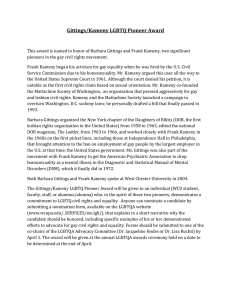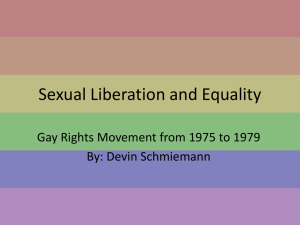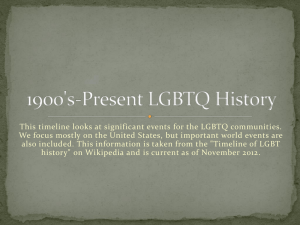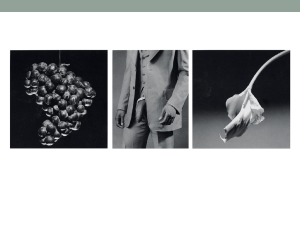Lesbian Gay Bisexual Transgender Pride Month 2013
advertisement
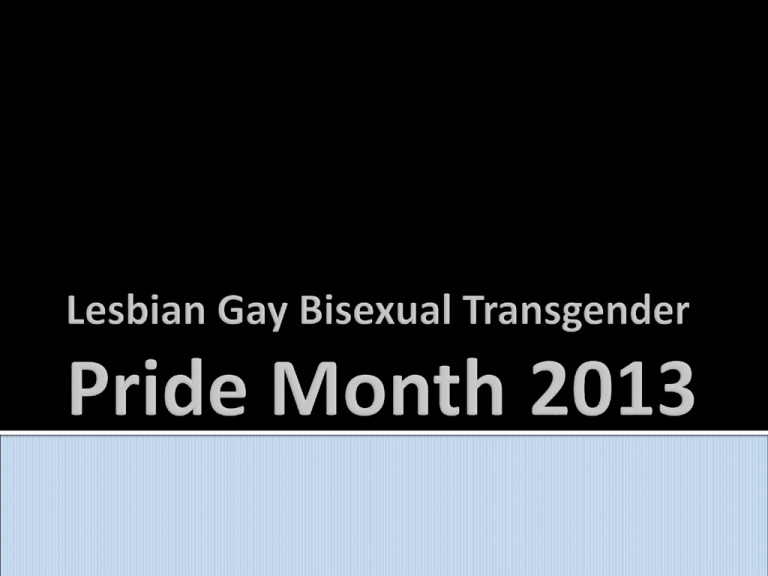
Lesbian, Gay, Bisexual and Transgender (LGBT) Pride Month is celebrated each June to honor the 1969 Stonewall riots in Manhattan, and to recognize the impact that LGBT individuals have had on history locally, nationally, and internationally. 2 “Injustice, experienced in the flesh, is the thing out of which change explodes.” —Margaret Mead American cultural anthropologist Margaret Mead (Photo courtesy of the Library of Congress) 3 Patrons of the Stonewall Inn in Greenwich Village rioted after police officers attempted to raid the popular gay bar that had been frequently raided by police officers trying to "clean out the deviants." Angry patrons clashed with police officers in the streets, leading to a three-day riot. 4 The Stonewall riots were recognized as the catalyst for the Gay Liberation movement in the United States. Scene of the Stonewall riots 1969 5 Still, the struggle had begun much earlier. Every movement for civil rights has its pioneers, who remain courageous in the face of daunting threat. They were brave enough to challenge the legal sanctions against homosexuality. 6 Today, we recognize one unsung hero of the struggle, Dr. Frank E. Kameny, who began fighting for gay rights more than a decade before the Stonewall riots. Frank Kameny (Photo courtesy of Kay Tobin Lahusen/NYPL) 7 Kameny didn’t start out wanting to be a gay activist. In 1940, he entered college to study physics. Before he completed his studies, he served in World War II. After the war he returned to school, and earned a doctorate in astronomy from Harvard University. Frank Kameny (Photo courtesy of the Kameny Project) 8 In July 1957, after teaching briefly at Georgetown University, he obtained a civil service job as an astronomer with the U.S. Army Map Service. It was soon afterward that an investigator from the Civil Service Commission began questioning him about reports that he was a homosexual. That autumn he was fired. 9 At the time, it was illegal to be gay and work for the federal government. As a result of the policy, over 10,000 gay and lesbian employees were forced out of their jobs during the 1950s and 1960s. In January 1958, Kameny was barred from federal government employment. 10 Kameny decided to sue. He lost. He appealed; again he lost. His lawyer deserted him, but he persevered. He brought the first civil rights action regarding sexual orientation to the Supreme Court of the United States, arguing that the government's actions toward gays were “an affront to human dignity.” 11 In March 1961, the Supreme Court denied his petition. Failing to prevail with his petition as an individual, Kameny decided it was time to organize. He rallied many others who had suffered similar injustices, and would fight to achieve the incremental steps needed to ultimately achieve equality for gays, lesbians, bisexuals, and transgender Americans. 12 In 1961, Kameny and his friend Jack Nichols founded the Mattachine Society of Washington, D.C. The goals of the society were, “To unify, to educate, and to lead." Thus began the battle to stop the arbitrary firing of federal employees based on their sexual orientation. 13 They started publishing a newsletter, The Gazette, which they mailed not only to their members, but to politicians and officials throughout Washington, including J. Edgar Hoover, director of the FBI. J. Edgar Hoover at his desk. 14 The Society maintained a relentless campaign to: eliminate discrimination on the basis of sexual orientation from civil service employment; grant security clearances; and qualify for military service. 15 In 1965, Kameny staged the first gay rights protests with ten others in front of the White House and Pentagon, demanding equality. Gay rights activists picket the White House on May 29, 1965. They all wore business attire to these events. (File photo - UPI) 16 Kameny realized that the battle for equality had to be fought on more than one front, and that the negative images of homosexuals— which had even permeated the self-identity of gay and lesbian people themselves—also had to be challenged. In 1966, he coined the slogan "Gay is Good." 17 Frank Kameny (Photo courtesy of the Kameny Papers) 18 In 1971, Kameny took on the American Psychiatric Association (APA), challenging their theories as unscientific and harmful to the psychological well-being of millions. He argued that being gay or lesbian shouldn't be described as a mental illness. “We’re not the problem. You’re the problem!’’ In 1973 the APA quit classifying homosexuality as a mental disorder. 19 Decisions in the U.S. Federal Courts slowly began to change. In 1975, after 18 years of persistent efforts by dedicated activists, the U.S. Civil Service Commission reversed its policies excluding homosexuals from government employment. 20 Yale Law Professor William Eskridge, an expert on the history of gay rights, maintains that Kameny was the original protester, strategist, and leader of this major social movement: “Frank Kameny was the Rosa Parks and the Martin Luther King and the Thurgood Marshall of the gay rights movement.” 21 Kameny’s years of protest were the impetus for President Clinton signing Executive Order 12968 in 1995 that allowed gay federal employees to obtain security clearances. President Bill Clinton 22 In 1998, Clinton signed Executive Order 13087, prohibiting discrimination based on sexual orientation in the competitive service of the federal civilian workforce. 23 President Obama with Kameny, after the signing. (Photo courtesy of Richard Perry/The New York Times) Kameny stood by President Obama’s side in the Oval Office as he signed Executive Order 12721 in 2009, which granted some benefits to same-sex partners of federal employees. 24 Kameny also received a formal apology in 2009 from the U.S. Civil Service Commission, for the "shameful action" of being fired solely based on his sexual orientation. "So in a sense, it took 50 years, but I won my case.” 25 On December 22, 2010, the "Don't Ask, Don't Tell" (DADT) Repeal Act became law. It provided for the repeal of DADT to be effective 60 days after the President, the Secretary of Defense, and the Chairman of the Joint Chiefs of Staff certified to Congress that the armed forces were prepared to implement the repeal. 26 Certification occurred July 22, 2011, and the repeal took place September 20, 2011. President Barack Obama signed the certification stating the statutory requirements for repeal of DADT have been met. 27 Before his death in 2011, Kameny said, “All I can say is from the long view, 50 years, we have moved ahead in a way that would have been absolutely unimaginable back then.” Dr. Franklin E. Kameny 1925-2011 28 “Each June, we commemorate the courageous individuals who have fought to achieve this promise for LGBT Americans, and we rededicate ourselves to the pursuit of equal rights for all, regardless of sexual orientation or gender identity." —President Barack Obama 29 www.whitehouse.gov www.fbi.gov www.kamenypapers.org www.loc.gov 30 Prepared by the Defense Equal Opportunity Management Institute, Patrick Air Force Base, Florida June 2013 All photographs are public domain and are from various sources as cited. The findings in this report are not to be construed as an official DEOMI, U.S. military services, or the Department of Defense position, unless designated by other authorized documents. 31
